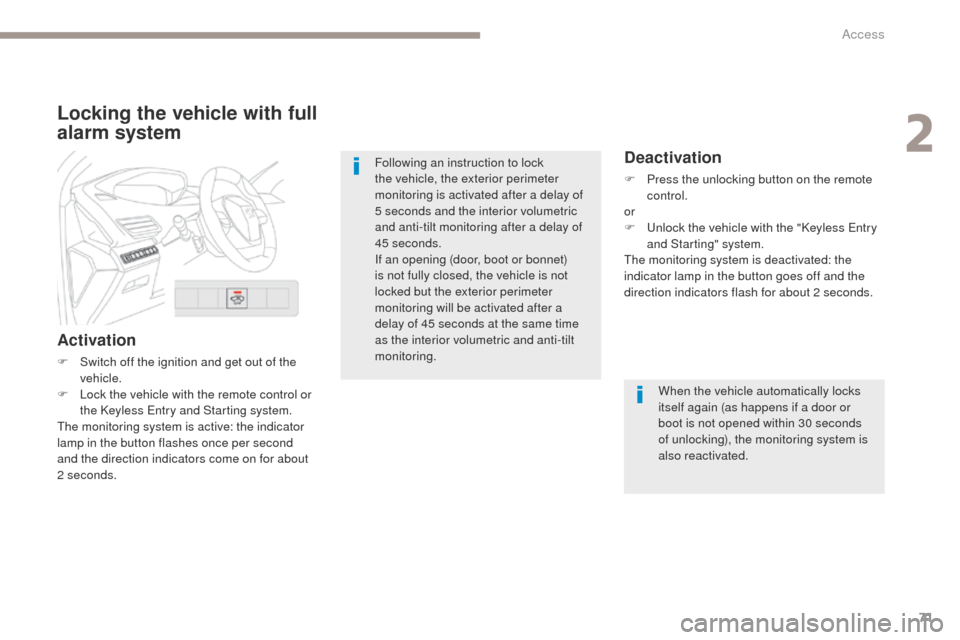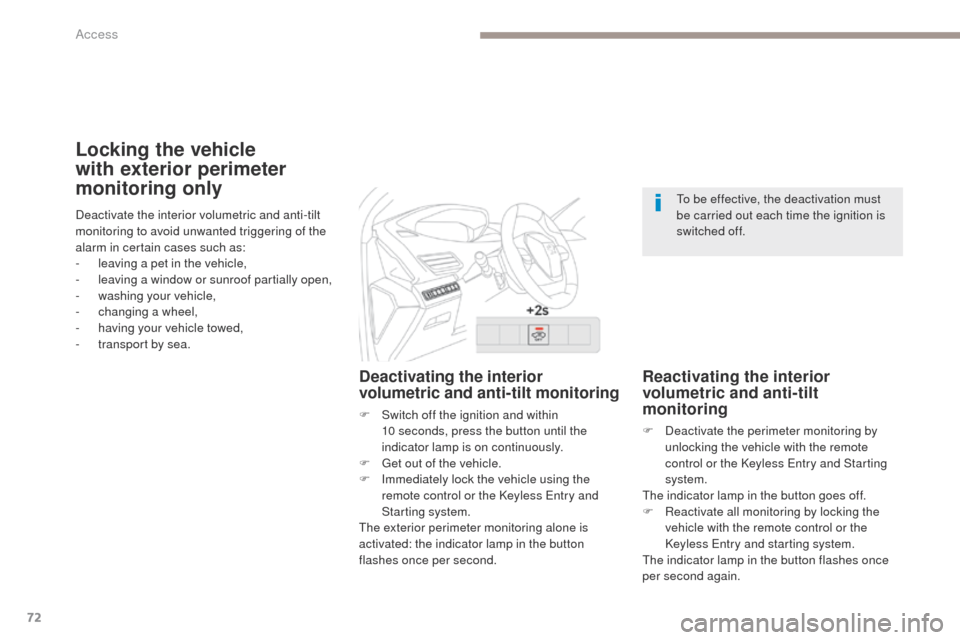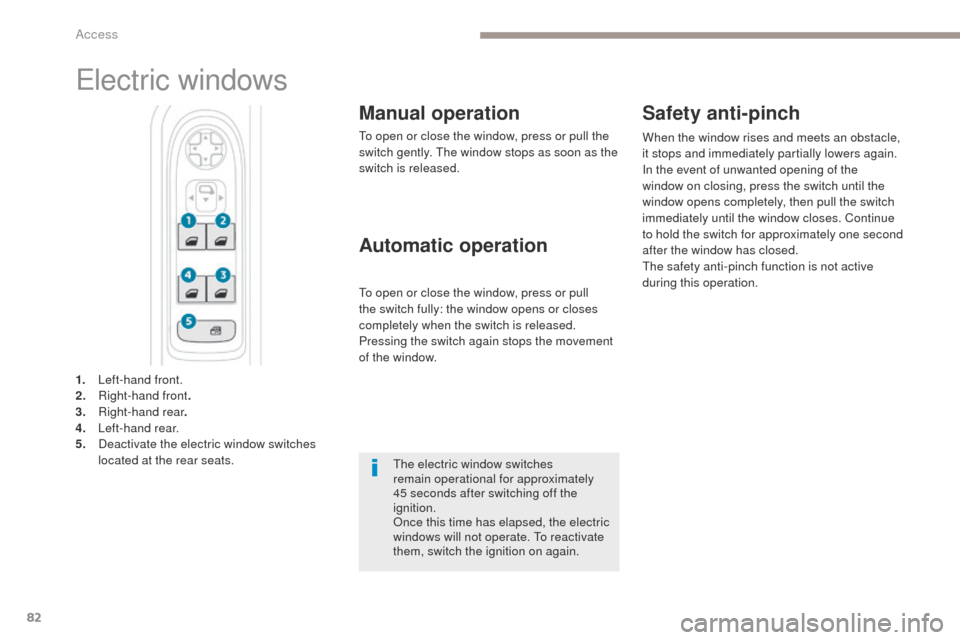Page 73 of 566

71
3008-2_en_Chap02_ouvertures_ed01-2016
Locking the vehicle with full
alarm system
Activation
F Switch off the ignition and get out of the vehicle.
F
L
ock the vehicle with the remote control or
the Keyless Entry and Starting system.
The monitoring system is active: the indicator
lamp in the button flashes once per second
and the direction indicators come on for about
2 seconds.
Deactivation
F Press the unlocking button on the remote control.
or
F
U
nlock the vehicle with the "Keyless Entry
and Starting" system.
The monitoring system is deactivated: the
indicator lamp in the button goes off and the
direction indicators flash for about 2 seconds.
Following an instruction to lock
the vehicle, the exterior perimeter
monitoring is activated after a delay of
5 seconds and the interior volumetric
and anti-tilt monitoring after a delay of
45 seconds.
If an opening (door, boot or bonnet)
is not fully closed, the vehicle is not
locked but the exterior perimeter
monitoring will be activated after a
delay of 45
seconds at the same time
as the interior volumetric and anti-tilt
monitoring.
When the vehicle automatically locks
itself again (as happens if a door or
boot is not opened within 30 seconds
of unlocking), the monitoring system is
also reactivated.
2
Access
Page 74 of 566

72
3008-2_en_Chap02_ouvertures_ed01-2016
Locking the vehicle
with exterior perimeter
monitoring only
Deactivating the interior
volumetric and anti-tilt monitoring
F Switch off the ignition and within 10 seconds, press the button until the
indicator lamp is on continuously.
F
G
et out of the vehicle.
F
I
mmediately lock the vehicle using the
remote control or the Keyless Entry and
Starting system.
The exterior perimeter monitoring alone is
activated: the indicator lamp in the button
flashes once per second.
Reactivating the interior
volumetric and anti-tilt
monitoring
F Deactivate the perimeter monitoring by unlocking the vehicle with the remote
control or the Keyless Entry and Starting
system.
The indicator lamp in the button goes off.
F
R
eactivate all monitoring by locking the
vehicle with the remote control or the
Keyless Entry and starting system.
The indicator lamp in the button flashes once
per second again.
Deactivate the interior volumetric and anti-tilt
monitoring to avoid unwanted triggering of the
alarm in certain cases such as:
-
l
eaving a pet in the vehicle,
-
l
eaving a window or sunroof partially open,
-
w
ashing your vehicle,
-
c
hanging a wheel,
-
h
aving your vehicle towed,
-
t
ransport by sea. To be effective, the deactivation must
be carried out each time the ignition is
switched off.
Access
Page 75 of 566

73
3008-2_en_Chap02_ouvertures_ed01-2016
Operating fault
When the ignition is switched on, fixed
illumination of the indicator lamp in the button
indicates a fault with the system.
Have it checked by a PEUGEOT dealer or a
qualified workshop.
Failure of the remote control
To deactivate the monitoring functions:
F u nlock the vehicle using the key (integral to
the remote control) in the driver's door lock,
F
o
pen the door; the alarm is triggered,
F
s
witch on the ignition; the alarm stops; the
indicator lamp in the button goes off.
Locking the vehicle without
activating the alarm
Triggering of the alarm
This is indicated by sounding of the siren
and flashing of the direction indicators for
30
seconds.
The monitoring functions remain active until
the alarm has been triggered eleven times in
succession.
When the vehicle is unlocked using the remote
control or the Keyless Entry and Starting
system, rapid flashing of the indicator lamp
in the button informs you that the alarm was
triggered during your absence. When the
ignition is switched on, this flashing stops
immediately.
F
L
ock or deadlock the vehicle using the
key (integral to the remote control) in the
driver's door lock.
2
Access
Page 84 of 566

82
3008-2_en_Chap02_ouvertures_ed01-2016
Electric windows
Manual operation
To open or close the window, press or pull the
switch gently. The window stops as soon as the
switch is released.
1.
L
eft-hand front.
2.
R
ight-hand front .
3.
R
ight-hand rear .
4.
L
eft-hand rear.
5.
D
eactivate the electric window switches
located at the rear seats.
Automatic operation Safety anti-pinch
To open or close the window, press or pull
the switch fully: the window opens or closes
completely when the switch is released.
Pressing the switch again stops the movement
of the window. When the window rises and meets an obstacle,
it stops and immediately partially lowers again.
In the event of unwanted opening of the
window on closing, press the switch until the
window opens completely, then pull the switch
immediately until the window closes. Continue
to hold the switch for approximately one second
after the window has closed.
The safety anti-pinch function is not active
during this operation.
The electric window switches
remain operational for approximately
45
seconds after switching off the
ignition.
Once this time has elapsed, the electric
windows will not operate. To reactivate
them, switch the ignition on again.
Access
Page 86 of 566

84
3008-2_en_Chap02_ouvertures_ed01-2016
Panoramic opening sunroof
The control buttons for the sunroof and blind
can be used:
-
w
ith the ignition on, if the state of charge of
the battery is adequate,
-
w
ith the engine running,
-
i
n STOP mode of Stop & Start,
-
d
uring the 45 seconds after switching off
the ignition,
-
d
uring the 45 seconds after locking the
vehicle.
Opening
The panoramic sunroof and its blind are
opened and closed using the buttons in the roof
console.
A.
B
lind control button.
B.
S
unroof control button.
Ensure that any luggage or accessories
carried on the roof bars do not inter fere
with the movement of the sunroof.
Do not place heavy loads on the fixed
or mobile glass of the sunroof.
Before operating the sunroof or blind
control buttons, ensure that no object or
person might prevent the movement.Principles
Complete opening of the sunroof involves partly
raising the mobile glass, then sliding it over the
fixed glass.
Any intermediate position is possible.
Opening the sunroof also opens its blind.
However, the blind can be left open when the
sunroof is closed. With the sunroof fully closed or
partly raised:
F
p
ress and release the rear of
button B without going beyond
the point of resistance to fully
raise the sunroof.
With the sunroof open in the raised position:
F
p
ress and release the rear of button B
without going beyond the point of
resistance to open the sunroof.
With the sunroof partly or fully closed:
F
p
ress and release the rear of button B
going beyond the point of resistance to fully
close the sunroof.
Any new action on this button interrupts the
movement.
Operating the sunroof
F Press and hold the rear of button B without going beyond the point of resistance; the
sunroof opens and stops when you release
the button.
Access
Page 90 of 566

88
3008-2_en_Chap03_ergonomie-et-confort_ed01-2016
Driving position
Adopting a good driving position helps improve your comfort and protection.
It also optimises interior and exterior visibility as well as access to controls.
Sitting comfortably
Driver
Sit fully back in the seat with your pelvis, back
and shoulders in contact with the seat backrest.
Adjust the height of the seat so that your eyes
are level with the middle of the windscreen.
Your head should be at a distance of at least
10 cm from the roof.
Adjust the longitudinal position of the seat so
that you can fully depress the pedals with your
legs still slightly bent.
Passenger
Sit fully back in the seat with your pelvis, back
and shoulders in contact with the seat backrest.
Adjust the longitudinal position of the seat so
that you are at a distance of at least 25 cm from
the dashboard.
Adjust the head restraint so that its upper edge
is level with the top of your head.
If your vehicle has electric seats, the
ignition must be on to adjust them.
The distance between your knees and the
dashboard should be at least 10 cm, for easy
access to the controls in the dashboard.
Adjust the seat backrest angle to the most
vertical position possible; the backrest must not
be reclined more than 25° from vertical.
Adjust the head restraint so that its upper edge
is level with the top of your head.
Adjust the length of the seat cushion to support
your thighs.
Adjust the lumbar support to fit the shape of
your spine.
Adjust the steering wheel so that it is at
distance of at least 25 cm from your chest
and
you are able to hold it with your arms slightly
bent.
The steering wheel must not obstruct your view
of the instrument panel.
As a safety measure, the seats and
steering wheel must only be adjusted
when stationary.
The presence in the vehicle of certain seat adjustments described in this section depends on the trim level and country of sale.
Ease of use and comfort
Page 91 of 566
89
3008-2_en_Chap03_ergonomie-et-confort_ed01-2016
Before moving off
If your vehicle has electric door mirrors,
the ignition must be on to adjust them.
When driving
Adjust the interior and exterior door mirrors so
as to reduce blind spots.Maintain a good driving position and hold the
steering wheel with both hands at the quarter
to three position, so that you can easily and
quickly reach the controls behind and near the
steering wheel.
Fasten your seat belt: place the diagonal belt in
the middle of your shoulder and adjust the lap
belt so that is tightened over your pelvis.
Ensure that all passengers have fastened their
seat belts correctly. Never adjust the seats or steering
wheel when driving.
Always keep your feet on the floor.
3
Ease of use and comfort
Page 96 of 566
94
3008-2_en_Chap03_ergonomie-et-confort_ed01-2016
Before moving the seat backwards,
ensure that there is nothing that might
prevent the full travel of the seat.
There is a risk of trapping or pinching
passengers if present in the rear seats
or jamming the seat if large objects are
placed on the floor behind the seat. To adjust the seat electrically, switch
on the ignition, or start the engine if the
vehicle has gone into energy economy
mode.
These electric adjustments remain
available for about a minute after
opening the driver's door. They are
deactivated about a minute after
switching off the ignition.
Electric driver's seat
Ease of use and comfort